From grooves to music, who isn’t amazed by the sound reproduction done by a vinyl record?
But grooves aren’t the only part of a vinyl record.
A record consists of many components that contribute to a smooth listening experience, extend the stylus’s lifespan, and convey all the necessary information to the end user.
You can even find out the manufacturer, sound engineers, disc cutting engineers, year of pressing, pressing plants, and much more.
Isn’t it interesting?
There is one more interesting fact that some records also have a hidden groove with additional music information that you might never have listened to.
Excited?
In this article, I have shared the anatomy of a vinyl record, along with the hidden information your record might have.
Let’s get started.
Parts of a Vinyl Record (Anatomy):
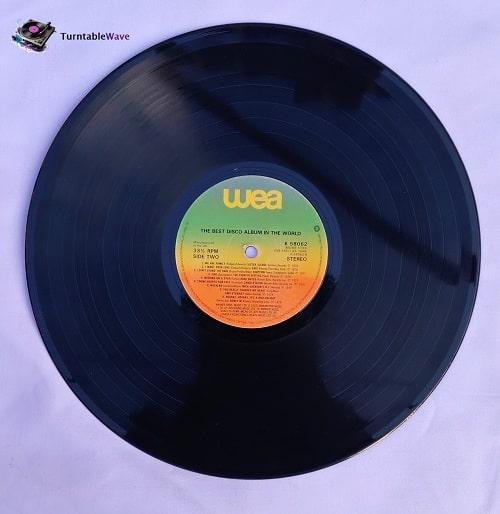
1) Run-in/lead-in groove
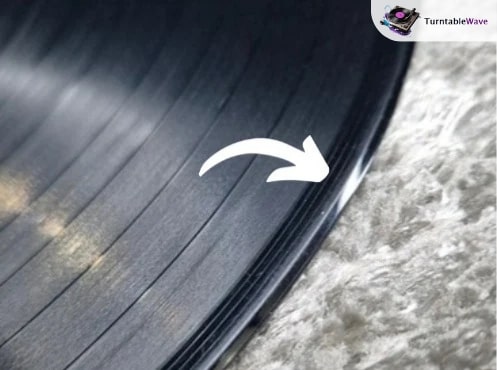
The run-in groove/area is a small, smooth, and ungrooved section on the outer edge of the record, which lies before the actual grooves that contain music information. It’s also known as the lead-in groove.
In the early 1920s, the world was introduced to automatic record changers, auto-replay adapters, and jukeboxes. In early record pressings, the distance between the groove and the record edge was less, which caused difficulties in dropping the stylus right to the beginning of the track.
In 1935, Decca introduced the concept of lead-in grooves. Soon after, every manufacturer started adding a lead-in groove to their records.
The purpose is to direct the stylus to the starting point of the grooves smoothly, eliminating the risk of damaging the stylus.
Most records don’t contain any music information in a run-in groove, but some records do.
For example: King Crimson’s USA, George Harrison’s Wonderwall Music, and the Dead Kennedys’ Plastic Surgery Disasters. These record starts from the lead-in groove.
2) Grooves (Audio information)
The record grooves are the physical representation of sound waves of a music track or any audio information.
Although it’s the simplest explanation of what record grooves are, it might still confuse beginners.
Let me make this much easier to understand.
A sound is a mix of vibrations at different scales that travels through the air, liquid, and gas. When we speak, play an instrument, clap our hands, or do anything with the intention to make noise, we create sound waves.
These sound waves travel through the air until they reach our ears. Our eardrums vibrate in response to these vibrations, and we hear the sound.
Similarly, the record grooves represent the sound waves that remained in the air, i.e., from the medium of sound creation until it reached our ears.
Here is the zoomed-in picture of the record groove.
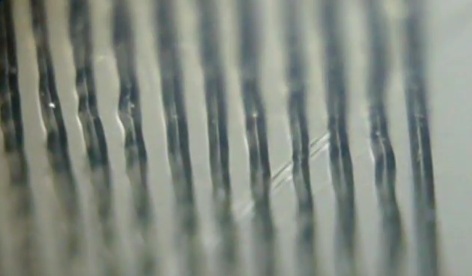
The grooves are V-shaped, which means when the stylus is positioned in between the grooves, there are two channels: left and right channels. The stylus runs in between these channels and vibrations.
The vibrations created by the stylus are similar to those of the microphone’s diaphragm during recording, which means that in playback, the opposite process of recording is performed by a turntable to produce sound.
That’s how music is created from grooves. For an in-depth explanation, I recommend reading this article How do vinyl records work?.
Many people ask me an interesting question, “How are grooves engraved on records?”.
Let’s discuss how physical sound waves are engraved on top of the record according to different eras.
How are sound waves engraved on records (Different eras of sound recording)?
From the late 1877s to the 1925, we were in the Acoustic Era of sound recording, where we used to record our sound using phonographs and gramophones. These legendary devices work solely on mechanical energy, and artists used to sing or play instruments in front of a horn.
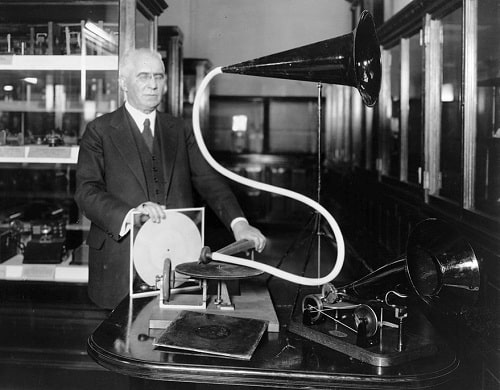
A diaphragm is attached under the horn, which converts the sound waves into vibrations. Under the diaphragm, a cutting stylus is attached that cuts the grooves on the record. I recommend learning the difference between a phonograph and a gramophone and how a phonograph works.
Then came the electrical era of sound recording (1925-1945), during which microphones, electronic signal amplifiers, and electromechanical recorders were introduced. Through these devices, the sound can now be amplified, filtered, and balanced.
The electrical era replaced the use of a horn with a microphone for recording. However, the process of groove engraving was still mechanical. Artists sang or played instruments in front of a microphone, where the microphone converted the sound waves into electrical signals through the diaphragm and transmitted them to the electronically powered disc-cutting head.
From 1945 to 1975, the magnetic era of sound recording emerged, and the process of engraving grooves remained largely unchanged from the electrical era.
Since the 1975s, the digital era of sound recording came, where artists sing or play instruments in front of a microphone. The microphone, with the help of a diaphragm, converts the sound waves generated into electrical signals, which are further stored in digital files.

These digital files are further mixed and mastered by sound engineers, and the electrical signals of the mastered file are further transmitted to the disc-cutting lathe’s stylus, and grooves are engraved on the record.
This is how grooves are engraved into records.
3) Run-out groove or Dead wax
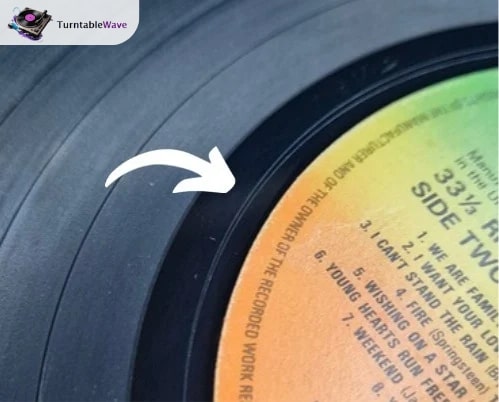
The run-out groove/area is the smooth, ungrooved section between the groove (containing music information) and the record label.
It doesn’t contain music information, but it has additional data, such as matrix number, album code, and unique messages that can be stamped or handwritten.
Some records even have information about who mastered the audio, when it was pressed, and record manufacturing-related information such as lacquer, mother, and stamper.
This section has multiple names, such as the run-off groove, end-groove area, matrix area, and obviously, run-out groove and Dead wax.
4) Grooves separator/divider
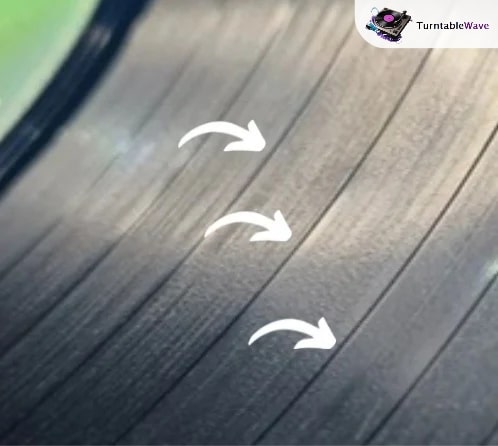
The groove separator or divider is a small ungrooved surface between the different tracks on the vinyl record.
For example, there are two songs: Song A and Song B, grooved on the record. On the record, you will see a small ungrooved gap between these songs, which represents the ending of Song A and the start of Song B.
5) Locked groove
A locked groove is a single loop, found on dead wax of some records, whose only purpose is to stop the stylus from dragging onto the label.
Most of the time, a locked groove doesn’t contain music information, which is why people call it a silent loop, but a locked groove on some records does contain music information.
For example: “Ace Ventura OST”, which has famous phrases from the film that you can listen to.
6) Label
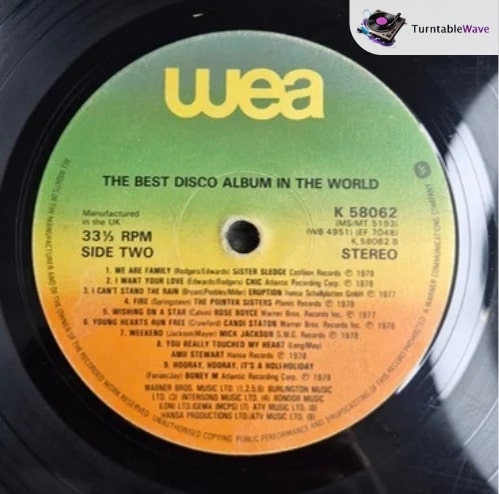
A record label, also known as a record sticker, is a paper circle pressed in the center of a record.
Many people think that it is added in the center after the record is pressed, but actually, it is a part of the vinyl pressing process.
In the manufacturing process, the top and bottom labels are added to the stampers. After that, a chunk of vinyl from the extruder is placed on the press. So, when the press stamps the records, the label gets stamped too.
The label may contain the following information:
- Artist’s information
- A list of tracks
- Side A or side B
- Album name
- The speed at which the record should be played
- Mono or Stereo
- The year it was pressed
The amount of information you see on labels depends on the manufacturer, pressing plant, era (the 50s, 60s, 70s, etc) in which it was pressed, and the country in which it was pressed.
7) Matrix Number
A matrix number is an alphanumeric code found on the dead wax or label. It can be either stamped or handwritten on dead wax.
Although the matrix number was added for internal use by the different record manufacturing plants, it became the main source of information for vinyl collectors.
Except for alphabets and numbers, it can also have a record plant codes or logos, signatures of the disc cutting engineer, mastering information, different pressing information, cut number, and much more.
The matrix number can be similar to the catalogue number, but both have different purposes.
For example, a record with a catalogue number “X-5432” can have a similar matrix number but with additional characters, symbols, logos, and cut numbers.
For the record, with the “X-5432” catalogue number, the matrix number can be A–5432 or X–5432–A on side one, and B–5432 or X–5432–B on side two.
8) Catalogue number, album code or UPC/Bar Code
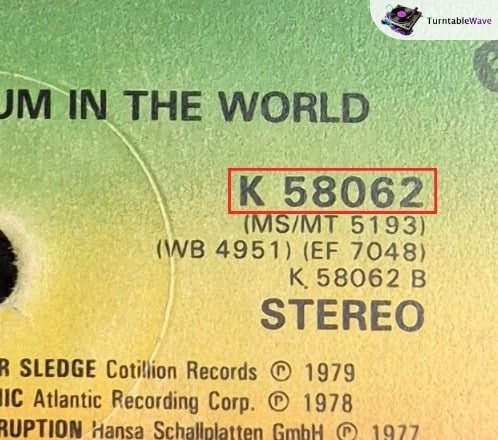
The catalogue number, album code, or UPC/Bar Code is added on the record label, sleeves by record labels when music is released. Some records do have a catalogue number in dead wax.
It’s a unique identification number containing alphanumeric digits whose purpose is to allow the record labels to control inventory and distribution, manage/track sales, and differentiate different releases.
Just like matrix numbers, catalogue numbers, album code, or UPC/Bar Code are used by vinyl collectors to gather more information about the record.
Vinyl collectors use matrix and catalogue numbers to identify the record’s actual worth.
9) Center/spindle hole
The spindle hole is a small hole located in the center of the record, whose purpose is to maintain the vinyl record in its place when spinning on the turntable. The spindle is a part of a record player, which is in the center of the Turntable’s platter.
In history, there were different diameters of holes until 1⁄4 inch (6.4 mm) was standardized, except for 45 RPM records.
The 45 RPM record has a larger hole in the center, measured as 1 1⁄2 inches (38 mm) in diameter. Since the turntable’s spindle supports 1⁄4 inch (6.4 mm), we need to add a 45 RPM adapter to play 45 RPM records on the turntable.
Interesting read: Why does 45 RPM sound better?
10) Album jackets and inner sleeves
Although album jackets and inner sleeves aren’t part of a vinyl record, they are directly related to it, so I have discussed these.
The jackets are the outer cardboard cover that protects our records. It is also known as an album cover or record cover. For dimensions of jackets and inner sleeves, I recommend checking this article: standard size of vinyl record cover.
The inner sleeves are the additional protective case of vinyl records. It stays inside the jackets and can be made up of plastic, cardboard, and paper. These are known as dust sleeves or an album liner.
In case of cardboard inner sleeves, your record provides two to three levels of protection:
- First protection with paper sleeves, anti-static or plastic sleeves
- Second protection with a cardboard inner sleeve
- Third protection with jackets or album/record cover.
That’s it.
Frequently Asked Questions:
Q1- What do you call the sleeve of a vinyl record?
The sleeve of a vinyl record is known as a record or album jacket and album or record cover.
Q2- What is the center part of a vinyl record called?
The center part of a vinyl record is known as the record label, which holds information about the vinyl record, such as the Artist’s information, a list of tracks, side A or side B, album name, the speed at which the record should be played, mono or stereo, and the year it was pressed.
Q3- What is the hole in a vinyl called?
The hole in a vinyl record is known as the center hole or spindle hole, whose purpose is to maintain the vinyl record in its place when spinning on the turntable.
We have shared the anatomy of a vinyl record along with a detailed description and history of the groove engraving process. If you have any questions, feel free to comment below. We will get back to you as soon as possible.


